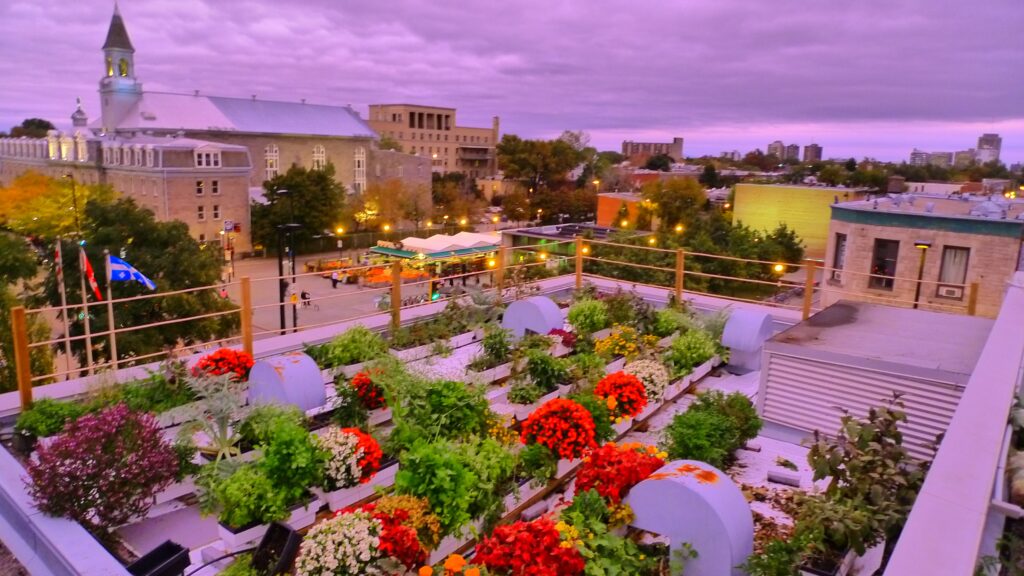Tomatoes on the roof, ferns on the walls… The Desjardins Group, Canada’s leading cooperative financial group and the fifth largest in the world, is taking the principle of sustainability to heart and introducing ground-breaking environmental initiatives at all levels – literally.
The roof of a bank might be one of the last places you’d expect to find an urban food garden. But the Caisse Populaire Desjardins du Mont-Royal, in downtown Montreal, is topped by a lush, brightly coloured mosaic: 30 kinds of fruits, vegetables, herbs and flowers, grown in Biotop gardening modules, including aubergines, chillies, basil and marigolds. The garden has environmental advantages, contributing to the bank’s carbon-neutral target, and community benefits, since the produce is given to local people.
Meanwhile, in Lévis, across the river from Quebec City, the Desjardin Group’s new headquarters features office space for 1,450 employees and the world’s tallest indoor vertical garden, a green wall of 11,000 plants reaching 65 metres high. Elkhorn ferns, philodendrons and pollutant-eliminating peace lilies are just some of the 42 species growing hydroponically in panels made from recycled water bottles and plastic bags. “The employees are very proud of the living wall,” says Pauline D’Amboise, Vice-President for Governance, Social Responsibility and Secretariat General for the Desjardins Group. “Sustainability is part of our DNA.”
The Desjardin Group’s cooperative identity and on-going commitment to community values have been essential to developing its current engagement with sustainability. The Caisse Populaire de Lévis, North America’s first savings and credit cooperative, was founded by Alphonse Desjardins and his wife Dorimène in 1900. They wanted to fight against usury, democratize access to credit, promote savings and economic education and support local development. The Desjardins Group continued to develop after Alphonse’s death, with hundreds more caisses founded. Insurance products were introduced and subsidiaries were later acquired or created in the fields of trust, mutual funds, industrial credit, investment, securities and assets management.
Today, the Desjardins Group has over 6 million members and clients, C$223billion in total assets and 864 service outlets and 376 caisses in Quebec and Ontario, plus 400 establishments offering services outside the caisse network and more than 20 entities and business units providing a large range of financial and insurance services. Active in 30 developing and emerging countries through Développement International Desjardins, the group also gives back C$1 million every day to members and communities through scholarships, sponsorships, donations and its non-profit foundation. Performance and social responsibility can clearly go together: in 2014, Bloomberg named Desjardins the strongest bank in North America, and number two in the world.
In the past decade, the group’s on-going commitment to community development has been joined by an engagement with environmental sustainability, with the living wall in Lévis just one of the more evident signs.
“We established a sustainable development policy as early as 2005,” explains Suzanne Gendron, Managing Vice-President for Cooperation and Corporate Affairs. As well as favouring socially responsible investment, such as financing renewable energy projects, the Desjardins Group also offers a range of green products for its customers, like loans to businesses to help them reduce energy consumption, a special rate for insurance for eco-friendly cars and a programme that encourages green home building and renovations.
The group has also come up with a list of actions to help it become sustainable in the way it runs its business, from encouraging ethical purchasing and redistributing surplus food left over from functions to facilitating the use of alternative transportation by its 45,000-plus employees. “We encourage employees to use car pools, public transport, bikes, electric cars,” says Pauline. “We have safe areas to park bikes at the buildings, beautiful showers – it’s like a hotel!”
Suzanne believes that the group’s cooperative structure has made it easier to introduce this move towards sustainability. “As a cooperative, we’re not looking just at short-term profits, but at the long-term impact of everything we do,” she says. “Whatever decision we make, we make it for our communities in the long term, so it’s normal to be investing in education, environment, cooperation, sustainable finance, microfinance. We know in the long term it will pay off and be in the best interest of our members. That’s why we exist.”
Story originally published in 2014 World Co-operative Monitor.



